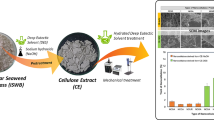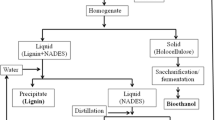Abstract
Inorganic salt pretreatment of lignocellulosic biomass has proven to be an efficient way to increase the efficiency of enzymatic saccharification. However, it is not clear that this improvement is the result of modification of the lignocellulosic substrate after pretreatment, or removal of inhibitor, or enhancement of cellulase or a combination of these events. Therefore, this study aimed to analyze the effects of inorganic salts on kinetics of cellulase enzymes (celluclast 1.5L and accellerase 1500). Two substrates rich in cellulose content [carboxymethylcellulose (CMC), avicel (AV)] and lignocellulose substrate [sugarcane bagasse (SB)] were considered. The enzymatic saccharification was carried with and without the addition of inorganic salts (NaCl and KCl) at 0.5 M and 1.0 M concentration. The kinetic parameters, Km and Vm, were determined to mechanically understand the pattern of inhibition and enhancement of inorganic salts on enzymatic saccharification. The kinetics parameters of celluclast 1.5L and accellerase 1500 for hydrolysis of CMC and AV with NaCl showed uncompetitive inhibition. Whereas, influences of KCl on both cellulase were differentiated to function in inhibition or enhancement modes when challenged with different substrates. On the other hand, enzymatic hydrolysis efficiencies of SB using both cellulases were enhanced under addition of NaCl and KCl, by increasing Vm of celluclast 1.5L from 0.303 to 0.635 mg/mL min (0.5 M KCl) and accellerase 1500 from 0.383 to 0.719 mg/mL min (1.0 M NaCl). The details of kinetic analysis in this work revealed the mechanism of inorganic salts on cellulase kinetics to be involved in substrate modification and removal of inhibitor.
Graphic abstract






Similar content being viewed by others
References
Shafiee S, Topal E (2009) When will fossil fuel reserves be diminished? Energy Policy 37:181–189. https://doi.org/10.1016/j.enpol.2008.08.016
Marriott PE, Gómez LD, Mcqueen-Mason SJ (2016) Unlocking the potential of lignocellulosic biomass through plant science. New Phytol. https://doi.org/10.1111/nph.13684
Nanda S, Azargohar R, Dalai AK, Kozinski JA (2015) An assessment on the sustainability of lignocellulosic biomass for biorefining. Renew Sustain Energy Rev 50:925–941. https://doi.org/10.1016/j.rser.2015.05.058
Cai J, He Y, Yu X et al (2017) Review of physicochemical properties and analytical characterization of lignocellulosic biomass. Renew Sustain Energy Rev 76:309–322. https://doi.org/10.1016/j.rser.2017.03.072
Sun Y, Cheng J (2002) Hydrolysis of lignocellulosic materials for ethanol production: a review. Bioresour Technol 83:1–11. https://doi.org/10.1016/S0960-8524(01)00212-7
Ahn Y, Lee SH, Kim HJ et al (2012) Electrospinning of lignocellulosic biomass using ionic liquid. Carbohydr Polym 88:395–398. https://doi.org/10.1016/j.carbpol.2011.12.016
Cheng Y-S, Mutrakulcharoen P, Chuetor S et al (2020) Recent situation and progress in biorefining process of lignocellulosic biomass: toward green economy. Appl Sci Eng Prog. https://doi.org/10.14416/j.asep.2020.08.002
Cheah WY, Sankaran R, Show PL et al (2020) Pretreatment methods for lignocellulosic biofuels production: current advances, challenges and future prospects. Biofuel Res J 7:1115–1127. https://doi.org/10.18331/BRJ2020.7.1.4
Sankaran R, Parra Cruz RA, Pakalapati H et al (2020) Recent advances in the pretreatment of microalgal and lignocellulosic biomass: a comprehensive review. Bioresour Technol. https://doi.org/10.1016/j.biortech.2019.122476
Baruah J, Nath BK, Sharma R et al (2018) Recent trends in the pretreatment of lignocellulosic biomass for value-added products. Front Energy Res. https://doi.org/10.3389/fenrg.2018.00141
Loow Y-L, Wu TY, Tan KA et al (2015) Recent advances in the application of inorganic salt pretreatment for transforming lignocellulosic biomass into reducing sugars. J Agric Food Chem 63:8349–8363. https://doi.org/10.1021/acs.jafc.5b01813
Lara-Serrano M, Fierro JLG, Morales-Delarosa S, Campos-Martín JM (2020) High enhancement of the hydrolysis rate of cellulose after pretreatment with inorganic salt hydrates. Green Chem 22:3860–3866. https://doi.org/10.1039/d0gc01066a
Liu L, Sun J, Cai C et al (2009) Corn stover pretreatment by inorganic salts and its effects on hemicellulose and cellulose degradation. Bioresour Technol 100:5865–5871. https://doi.org/10.1016/j.biortech.2009.06.048
Kamireddy SR, Li J, Tucker M et al (2013) Effects and mechanism of metal chloride salts on pretreatment and enzymatic digestibility of corn stover. Ind Eng Chem Res. https://doi.org/10.1021/ie3019609
Huo D, Danni X, Yang Q et al (2018) Improving the efficiency of biomass pretreatment and enzymatic saccharification process by metal chlorides. BioResources. https://doi.org/10.15376/biores.13.1.1909-1916
Miller GL (1959) Use of dinitrosalicylic acid reagent for determination of reducing sugar. Anal Chem 31:426–428. https://doi.org/10.1021/ac60147a030
Rattanaporn K, Tantayotai P, Phusantisampan T et al (2018) Organic acid pretreatment of oil palm trunk: effect on enzymatic saccharification and ethanol production. Bioprocess Biosyst Eng 41:467–477. https://doi.org/10.1007/s00449-017-1881-0
Robinson PK (2015) Enzymes: principles and biotechnological applications. Essays Biochem 59:1–41. https://doi.org/10.1042/BSE0590001
Jiang Z, Yi J, Li J et al (2015) Promoting effect of sodium chloride on the solubilization and depolymerization of cellulose from raw biomass materials in water. Chemsuschem 8:1901–1907. https://doi.org/10.1002/cssc.201500158
Wang H, Gurau G, Rogers RD (2012) Ionic liquid processing of cellulose. Chem Soc Rev 41:1519. https://doi.org/10.1039/c2cs15311d
Kang KE, Park D-H, Jeong G-T (2013) Effects of inorganic salts on pretreatment of Miscanthus straw. Bioresour Technol 132:160–165. https://doi.org/10.1016/j.biortech.2013.01.012
Zhang X, Zhang W, Lei F et al (2020) Coproduction of xylooligosaccharides and fermentable sugars from sugarcane bagasse by seawater hydrothermal pretreatment. Bioresour Technol 309:123385. https://doi.org/10.1016/j.biortech.2020.123385
Hall M, Bansal P, Lee JH et al (2010) Cellulose crystallinity—a key predictor of the enzymatic hydrolysis rate. FEBS J 277:1571–1582. https://doi.org/10.1111/j.1742-4658.2010.07585.x
Strelow J, Dewe W, Iversen PW et al (2004) Mechanism of action assays for enzymes. In Assay Guidance Manual. https://www.ncbi.nlm.nih.gov/books/NBK92001/
Shuler MLKF (1992) Bioprocess engineering: basic concepts. J Control Release 22:293. https://doi.org/10.1016/0168-3659(92)90106-2
Wagner M (1976) Enzyme kinetics, behavior and analysis of rapid equilibrium and steady-state enzyme systems (Segel, Irwin H.). J Chem Educ 53:A472. https://doi.org/10.1021/ed053pa472
Gruno M, Väljamäe P, Pettersson G, Johansson G (2004) Inhibition of the Trichoderma reesei cellulases by cellobiose is strongly dependent on the nature of the substrate. Biotechnol Bioeng 86:503–511. https://doi.org/10.1002/bit.10838
Aravamudhan A, Ramos DM, Nada AA, Kumbar SG (2014) Natural polymers: polysaccharides and their derivatives for biomedical applications. In: Natural and synthetic biomedical polymers. Elsevier, Amsterdam, pp 67–89. https://doi.org/10.1016/B978-0-12-396983-5.00004-1
Choi Y, Maken S, Lee S, Chung E, Park J, Min B (2007) Characteristics of water-soluble fiber manufactured from carboxymethylcellulose synthesis. Korean J Chem Eng 24:288–293. https://doi.org/10.1007/s11814-007-5050-z
Ghose TK (1987) Measurement of cellulase activities. Pure Appl Chem 59:257–268. https://doi.org/10.1351/pac198759020257
Siqueira G, Arantes V, Saddler JN et al (2017) Limitation of cellulose accessibility and unproductive binding of cellulases by pretreated sugarcane bagasse lignin. Biotechnol Biofuels 10:176. https://doi.org/10.1186/s13068-017-0860-7
Brandt SC, Brognaro H, Ali A et al (2021) Insights into the genome and secretome of Fusarium metavorans DSM105788 by cultivation on agro-residual biomass and synthetic nutrient sources. Biotechnol Biofuels. https://doi.org/10.1186/s13068-021-01927-9
Castaño PH, Reales AJG, Zapata MJ (2015) Enzymatic hydrolysis of cassava stalks pretreated with the alkaline method. Agron Colomb 33:238–243. https://doi.org/10.15446/agron.colomb.v33n2.50115
Bhattacharyya D, Singh KS (2010) Colour removal and the effect of reactive dyes on growth substrate utilization by an unacclimated ethanol-enriched anaerobic culture. Water Qual Res J Canada 45:307–315. https://doi.org/10.2166/wqrj.2010.033
Scott BR, Huang HZ, Frickman J et al (2016) Catalase improves saccharification of lignocellulose by reducing lytic polysaccharide monooxygenase-associated enzyme inactivation. Biotechnol Lett 38:425–434. https://doi.org/10.1007/s10529-015-1989-8
Tantayotai P, Rattanaporn K, Tepaamorndech S et al (2019) Analysis of an ionic liquid and salt tolerant microbial consortium which is useful for enhancement of enzymatic hydrolysis and biogas production. Waste Biomass Valor 10:1481–1491. https://doi.org/10.1007/s12649-017-0186-5
Sriariyanun M, Tantayotai P, Yasurin P et al (2016) Production, purification and characterization of an ionic liquid tolerant cellulase from Bacillus sp. isolated from rice paddy field soil. Electron J Biotechnol 19:23–28. https://doi.org/10.1016/j.ejbt.2015.11.002
Hassan N, Khairil Anwar NAK, Idris A (2020) Strategy to enhance the sugar production using recyclable inorganic salt for pre-treatment of oil palm empty fruit bunch (OPEFB). BioResources 15:4912–4931. https://doi.org/10.15376/biores.15.3.4912-4931
Moodley P, Kana EBG (2017) Microwave-assisted inorganic salt pretreatment of sugarcane leaf waste: effect on physiochemical structure and enzymatic saccharification. Bioresour Technol 235:35–42. https://doi.org/10.1016/j.biortech.2017.03.031
Mutrakulcharoen P, Pornwongthong P, Cheenkachorn K et al (2020) Inhibitory effect of inorganic salts residuals on cellulase kinetics in biofuel production from lignocellulose biomass. In: 2020 International conference and utility exhibition on energy, environment and climate change (ICUE). IEEE, New York, pp 1–8. https://doi.org/10.1109/ICUE49301.2020.9307055
Choi B, Rempala GA, Kim JK (2017) Beyond the Michaelis-Menten equation: accurate and efficient estimation of enzyme kinetic parameters. Sci Rep 7:17018. https://doi.org/10.1038/s41598-017-17072-z
Silverstein TP (2019) When both Km and Vmax are altered, is the enzyme inhibited or activated? Biochem Mol Biol Educ 47:446–449. https://doi.org/10.1002/bmb.21235
Xiao Z, Zhang X, Gregg DJ, Saddler JN (2004) Effects of sugar inhibition on cellulases and β-glucosidase during enzymatic hydrolysis of softwood substrates. Appl Biochem Biotechnol 115:1115–1126. https://doi.org/10.1385/ABAB:115:1-3:1115
Qing Q, Yang B, Wyman CE (2010) Xylooligomers are strong inhibitors of cellulose hydrolysis by enzymes. Bioresour Technol 101:9624–9630. https://doi.org/10.1016/j.biortech.2010.06.137
Acknowledgements
The authors would like to thank King Mongkut’s University of Technology North Bangkok (Grant Contract Number KMUTNB-KNOW63-28, KMUTNB-Post-64-05) for the financial support during this work.
Author information
Authors and Affiliations
Contributions
All authors contributed to the conception and design of research towards the study related to kinetics of commercial cocktail enzymes with and without addition of inorganic salts. The original draft was written by MPG and ASST. The manuscript was reviewed and edited by Y-SC, and PT. The final version of the draft has been edited, reviewed and approved by MS. All authors have contributed, read and approved the final version of the draft.
Corresponding author
Ethics declarations
Conflict of interest
The authors declare no competing interest.
Additional information
Publisher's Note
Springer Nature remains neutral with regard to jurisdictional claims in published maps and institutional affiliations.
Rights and permissions
About this article
Cite this article
Paulraj Gundupalli, M., Sahithi S T, A., Cheng, YS. et al. Differential effects of inorganic salts on cellulase kinetics in enzymatic saccharification of cellulose and lignocellulosic biomass. Bioprocess Biosyst Eng 44, 2331–2344 (2021). https://doi.org/10.1007/s00449-021-02607-6
Received:
Accepted:
Published:
Issue Date:
DOI: https://doi.org/10.1007/s00449-021-02607-6




